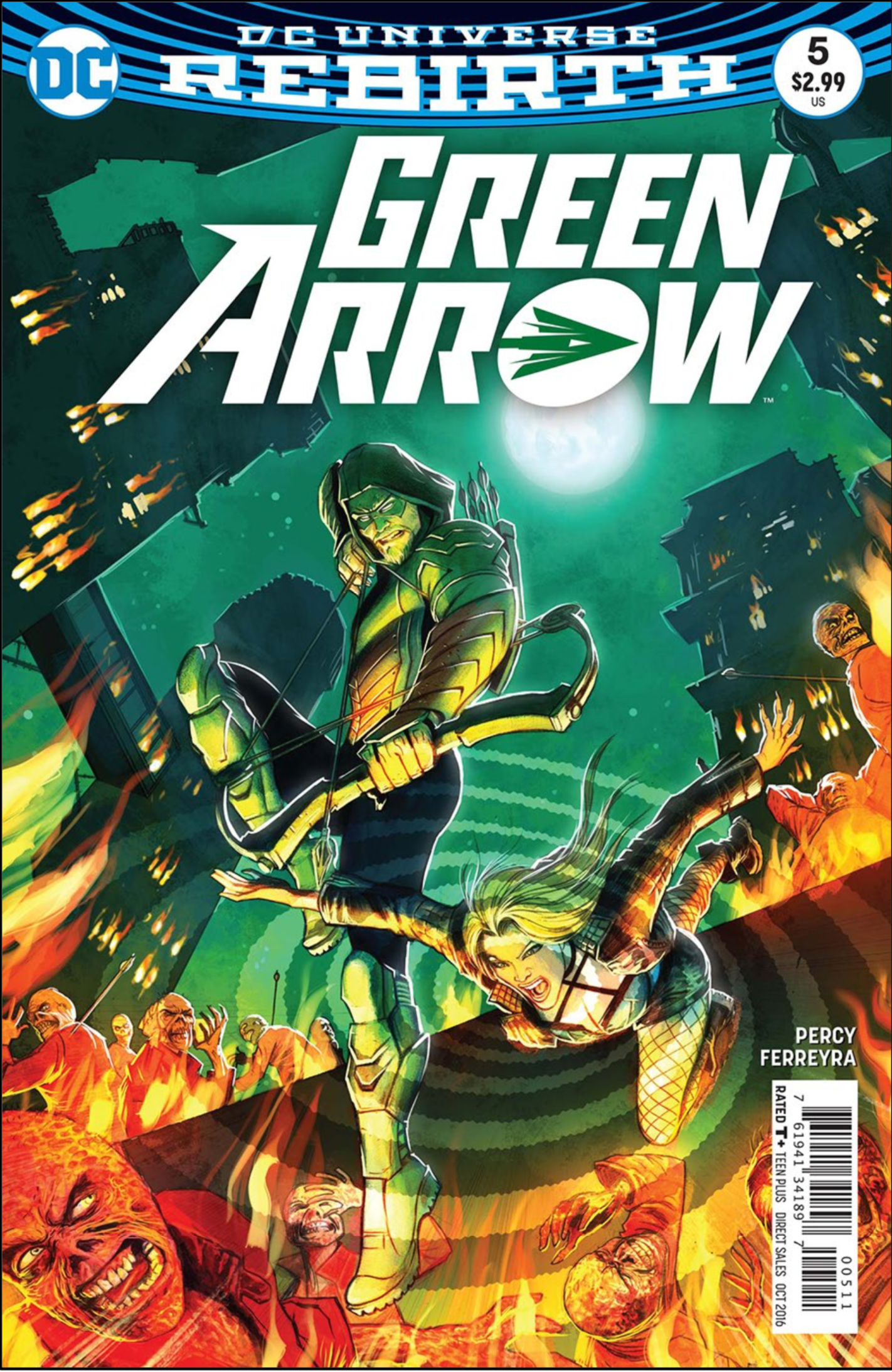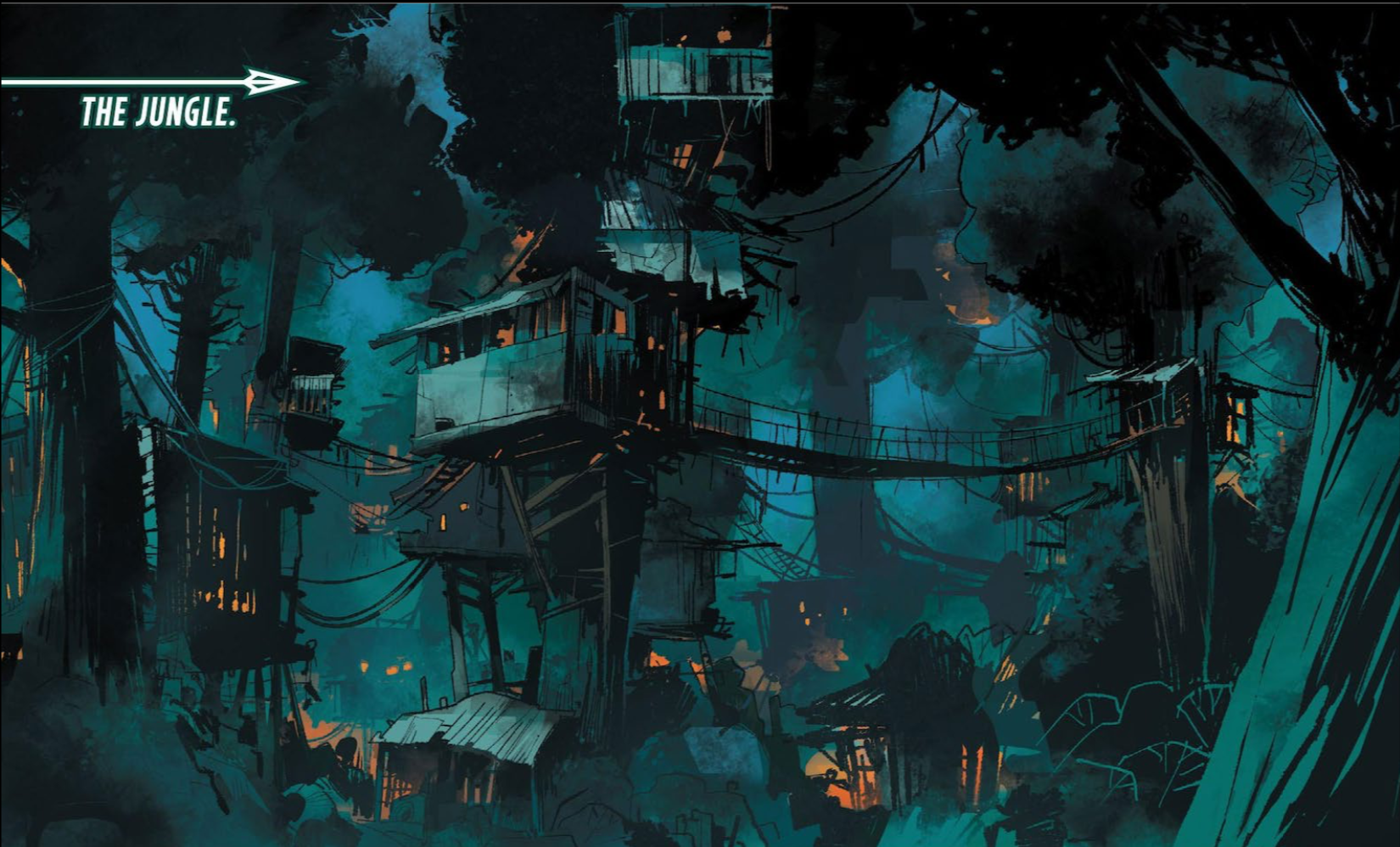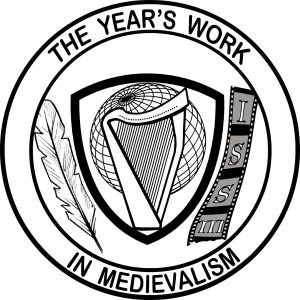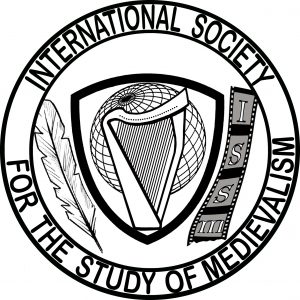Karl Fugelso
Towson University
Few foundational texts are represented as often in graphic novels as is Dante’s Divine Comedy. Usually the references are merely in passing, as with Joe Brusha’s and Ralph Tedesco’s Inferno: Age of Darkness (“Mercy Dante is Back!”).1 But sometimes the Commedia facilitates an extended catharsis, as for Nightcrawler and his girlfriend in Chris Claremont’s and John Romita Jr.’s X-Men Annual #4,2 or a prolonged meditation on style, as in Seymour Chwast’s Dante’s “Divine Comedy”: A Graphic Adaptation.3 And occasionally it is the primary subject of an entire graphic novel, as with Guido Martina’s and Angelo Bioletto’s L’inferno di Topolino.4 Yet perhaps no graphic novel is as faithful to the Commedia as Green Arrow Volume I: The Death and Life of Oliver Queen.5 Though dropping a Robin Hood wannabe into the Inferno may seem strange, it is precisely in that and other departures from the letter of Dante’s text that the writer Benjamin Percy and the artists Otto Schmidt and Juan Ferreyra come closest to its spirit. Even as they superficially break from and may even seem to reject a cornerstone of Western literature, they actually adhere to it on a deeply profound level. By doing so, they bolster their work’s power and legitimacy while (re)introducing Dante to audiences who might not otherwise appreciate the Commedia‘s ongoing relevance, or that of the Middle Ages in general.6
The Death and Life of Oliver Queen, which DC Comics originally spread across six biweekly issues from June 1 to August 17, 2016, and united as a trade paperback in 2017, is somewhat of a reboot for this series, with Green Arrow’s alter ego, Oliver Queen, readjusting to life as a corporate titan after five years stranded on an uncharted island.7 As the first issue (aptly titled “Rebirth”) opens, Queen’s free expression of his liberal values has just prematurely ended a dinner date with the daughter of a Republican senator. Shortly after Queen leaves the restaurant, he encounters a homeless mother and child to whom he gives a hundred dollars before setting out on a walk and explaining in a voiceover that he wants to be seen as a social-justice warrior. Meanwhile, the mother disappears down a storm-drain and a hooded figure abducts the child, which naturally brings Queen back to the scene as Green Arrow. The hooded figure turns out to be Dinah Laurel Lance, Queen’s future wife and a pop-music star who moonlights as Black Canary, a combat expert with a voice that can literally kill. Together they question whether this act is truly that of a great social-justice warrior and learn that the child’s mother and many other street people have been kidnapped by the so-called Underground Men and secretly auctioned to other villains. Queen then discovers that his own firm has been complicit in at least shipping the abductees, and we learn that not only is his right-hand man the local head of the abductors, but Queen’s stepmother, Shado,8 and his half-sister, Emiko (Emi) Queen, with whom he and Black Canary have just become temporary roommates, are apparently working for the criminals. Indeed, Shado and Emi render Queen unconscious and set him adrift in a boat with planted drugs and enough blood to suggest that he is responsible for the recent death of his secretary. Fortunately, Queen falls overboard and is rescued by his part-time assistant, Henry Fyff, while Black Canary vows to investigate Queen’s uncharacteristic behavior, and while Queen’s part-time bodyguard, John Diggle, learns on a Middle Eastern mission that his path also leads to the criminals. Once Queen recovers, he sets off to break into his own corporate headquarters, where the villains, under his former assistant, have a base. As Queen discovers the assistant’s treachery, Diggle learns the location of the arch-villain’s main headquarters from a Rome informant named Virgil; Black Canary learns the same from researching the swirly sign on the boat from which Queen fell overboard; and we learn that the arch-villain is a flayed figure in red who calls himself Dante, his organization The Ninth Circle, and his boat Inferno. After this monster takes Black Canary hostage with the help of Shado and Emi, Queen and Diggle link up and set out to rescue her before the villain can dunk her, like all of his other abductees, in burning lye that apparently helps brainwash them into becoming his minions. Since this is a DC comic, which are famous for their idealism,9 Emi turns out not to have betrayed her half-brother. Moreover, she joins him and Diggle in rescuing Black Canary shortly before the latter sonically knocks the arch-villain into the burning lye, and the heroes blow up the ship one panel before Queen wakes to find himself exiled yet again on the shores of another island.
Though even that brief summary makes clear that Percy, Schmidt, and Ferreyra repeatedly and explicitly refer to the Commedia, they obviously are not completely beholden to Dante’s text. Indeed, they often depart quite far from and perhaps even betray, or at least distort, it. Queen may echo the Commedia‘s narrator-protagonist in suffering exile after his quest (and echo the Commedia‘s author in suffering exile before that quest), but as a brash corporate titan who dresses like Robin Hood and seeks to help the persecuted via a quiver of trick arrows, he is far from the Commedia‘s comparatively timid, unarmed, and at least ostensibly humble pilgrim.10 Nor might the parallel seem to be improved by having Diggle, Black Canary, and Emi join Queen on his journey, not to mention the fact that, despite Diggle’s otherwise obvious role as a sidekick, he is the only one of the four who meets a guide named Virgil. But perhaps the biggest obstacle to seeing this graphic novel as a second Commedia is the identification of the arch-villain as Dante. If the Commedia‘s narrator-protagonist is far from Queen in character and personality, he would seem to be absurdly distant from a monster who crows about dipping abductees in burning lye to make them more like him and who knowingly sells other prisoners to acknowledged slavers and cannibals.
Yet even as such departures from the Commedia may suggest Percy, Schmidt, and Ferreyra did not have a thorough understanding of Dante’s text and/or chose to pervert it, they often invoke the Commedia in subtle, sophisticated, and meaningful ways. One of the trade paperback’s two frontispiece illustrations (which was originally the cover to the sixth issue, “Inferno”) depicts a light-green swirl that echoes the structure of the Commedia‘s hell and is superimposed on Green Arrow and Black Canary as they descend in front of burning buildings and among flaming figures.

Figure 1: Juan Ferreyra, cover art for Green Arrow Rebirth (2016)
Figure 1.11
In the opening scenes of the first issue’s main body, Queen’s date storms away after accusing him of a sanctimonious, holier-than-though attitude that smacks of the manner in which Dante humble-brags about himself in the Commedia.12 This characterization is echoed by Black Canary’s claim a few pages later that the Justice League and “GOTHAM CREW” would agree with the senator’s daughter.13 Just prior to that claim we learn that the abductors of the mother to whom Queen gives a hundred dollars are known as the “UNDERGROUND MEN,” a label that clearly invokes the denizens of Dante’s Hell. Black Canary attacks Queen shortly thereafter, and on repeated occasions later, for that most Dantean of sins, hypocrisy, as he, the inheritor of a massive corporate empire, condemns “THE MAN.” As Queen and Black Canary subsequently set out to find the Underground Men, and enter a congested Seattle slum of flame-lit shanties that strongly invokes the crowded dark forest in Inferno I, we discover or are reminded that, like Dante in exile, Queen learned to care about others in new ways while stranded on his uncharted isle.14

Figure 2: Juan Ferreyra and Otto Schmidt, art for Green Arrow (2016)
Figure 2.15
After many more panels in dark settings occupied by the Underground Men, as they auction their abductees and are chased by Green Arrow and Black Canary, the audience learns that Queen’s right-hand man is, in fact, the local leader when the villain digs his mask out from a drawer using a key whose swirly handle matches the spiral on the trade paperback’s frontispiece and invokes the mesmerizing spiral path of Dante’s protagonist. Shortly thereafter Black Canary, Shado, and Emi appear on the cover of the third issue as three disembodied heads that echo those of the souls Dante meets in Paradiso.16 And a far more overt reference to the Commedia, at least in retrospect, occurs five pages later when Shado and Emi refer to the villains as “THE BURNED.”
But even that allusion pales in blatancy to Shado subsequently informing Emi, as they board the arch-villain’s large, black, flame-lit ship, that this vessel is “THE INFERNO. WHERE WE WILL CONTINUE OUR SERVICE TO THE NINTH CIRCLE.” From this point, many of the references become more obvious, as the audience learns the arch- villain is named Dante; Black Canary discovers from a phone search that the villains’ trademark swirl represents “THE NINE CIRCLES OF HELL”; she immediately thereafter quotes the first stanza of the Commedia and observes that it comes “FROM DANTE’S INFERNO”;17 and the arch-villain quotes the first three lines of the famous inscription over the Commedia‘s gate of hell as he dips a victim in lye. 18 Yet even amid such overt and sometimes highly unorthodox allusions are subtle ones that embody conventional but remarkably deep understanding of the Commedia, as well as faithfulness to its spirit and perhaps its letter. For instance, as Black Canary quotes the Commedia‘s opening lines, we see Queen stumbling down a dark alley of trees and trying to climb a slope19 that, like the Seattle shanty town seen earlier in the series, strongly invoke Dante’s selva oscura; the Virgil whom Diggle consults for directions does indeed function as a guide, albeit purely through words; Diggle says, in accord with the Commedia‘s penal structure, that Emi must go to the Ninth Circle since she’s a traitor; and in harmony with the Commedia‘s principle of contrapasso—that is, punishments that suit their crime—the arch-villain falls in his own vat of burning lye.20
These comparatively sophisticated references suggest that the graphic novel’s ostensible distortions of the Commedia may in fact harmonize with and even promote its spirit. It is not hard to see the arch-villain’s dark, red-lit, mountainous ship as an inversion of the Commedia‘s infernal pit, particularly when Queen and his allies must overcome myriad obstacles to get through that ship.21 The Ninth Circle organization is indeed treacherous as it bankrolls crime, trafficks in women and children, and destroys many of its clients. And though purists may not like the conflation of the Commedia‘s Dante with a monster who dips people in burning lye and wears a blood-red suit, the arch-villain’s recitation of the inscription over the gate of hell echoes the Commedia‘s invitation to read those words as the narrator’s own, for in fourteenth-century manuscripts they appear at the beginning of Canto Three with no pre-announced source or other indication that he is in fact quoting them.22 Moreover, though Dante as author and narrator often downplays his agency in the Commedia, he sometimes allows that he may be responsible for at least the form, if not the content, of the text, and, as suggested by numerous fifteenth-century and later commentators, he never rules out the possibility that it is entirely his invention.23 Thus, as the arch-villain claims to be purifying souls and making them more like him, albeit while dipping them in burning lye, he is not so far from those moments when the Commedia‘s Dante suggests he is articulating his experiences to help the reader join him on the path to grace.24
That fusion of audience with a character may seem to be impeded in the graphic novel by the identification of the Commedia‘s Dante with not only the arch-villain but also Queen, Diggle, Emi, and perhaps everyone else who temporarily accompanies Queen on his quest. But in something of a parallel to the way in which the Commedia encourages the reader to identify with Dante by selectively shifting agency among his roles as author, narrator, and protagonist,25 the fluidity with which the novel’s characters parallel the Commedia‘s protagonist and sometimes its narrator may optimize the audience’s opportunities to experience the novel from a first-person perspective, for though none of the major figures in it are much like what is conventionally called an “everyman,” splitting the Commedia‘s Dante among at least four figures dilutes the qualifications necessary to function as the protagonist. That is, shifting the identification of Dante among four figures underscores the mobility of that identification and thereby facilitates its transference to the reader.
Yet, even if the audience does not identify with any of the figures in the novel, the conflation of the arch-villain with Dante may still conform with the spirit of the Commedia precisely to the degree that this elision seems to depart from it. Since the novel suggests that the arch-villain named himself, the degree to which the audience sees that as a misinterpretation of the Commedia is the degree to which they may assume the arch- villain is blindingly narcissistic, ignorant, stupid, and/or deceptive. Many other graphic- novel monsters—not to mention many of the genre’s heroes, such as Green Arrow—seek to flatter and legitimize themselves by taking on the identity of literary and/or historical figures long admired by the Establishment. But if, as may be the case here, the villain and his or her referent are seen as too far apart in behavior, much less morality, the gap may in fact be highlighted by the attempt to collapse it. That is, if the Commedia Dante is seen as he often portrays himself, as fundamentally good, humble, pious, and beneficent, then the arch-villain’s frequent displays of the opposite qualities may stand out all the more.
Such a reading would, of course, require at least some familiarity with the Commedia and would particularly profit from a close study of how it portrays Dante. But the novel’s departures from the Commedia may also operate on another level, one that is more pop than academic and is not entirely out of step with the way in which many non-scholars evidently see Dante’s narrative. Even for many people who have never read the Commedia, or only vaguely remember it from school, Dante’s first cantica has become a common referent for a torturous experience, particularly passing through a dark, confusing gauntlet of constant danger, as suggested by a recent newspaper description of a notorious parking-garage in my city26 and by the slang use of “ninth circle” to mean something horrendous. Thus, no matter how knowledgeable Percy, Schmidt, and Ferreyra may have been about the Commedia when they composed The Death and Life of Oliver Queen, and regardless of how sophisticated they may have expected their audience to be, every one of their allusions to the Commedia, no matter how far from the letter and spirit of the text as Dante perceived it, may, to the degree that the audience has at least a pop knowledge of Dante’s narrative, underscore the hazards of Green Arrow’s mission.
At least some of the graphic novel’s ostensible disruptions of the Commedia, therefore, may not be departures from its spirit at all, may be distortions by the arch-villain that betray him and thereby support the Commedia‘s values, and/or may align with a pop understanding of Dante’s text, even as they depart from academic interpretations of it. What may at first appear to be errors in the graphic novel may actually reinforce its themes and, in doing so through a literary classic, not only legitimize them in the eyes of some critics but also update that source and introduce it to new audiences. In one final parallel to a medieval author who pioneered the use of the vernacular for elite writing, Percy, Schmidt, and Ferreyra rely on powerful and complex literary allusions to propel their narrative in a medium often denigrated for its lack of subtlety and sophistication. They demonstrate that a graphic novel can meaningfully deploy medievalism in creative new juxtapositions that underscore the ongoing relevance of the Middle Ages, their interpreters, and, I hope, we interpreters of those interpreters.
- Joe Brusha, Ralph Tedesco et al, Inferno: Age of Darkness (Horsham: Zenescope Entertainment, 2014).
- Chris Claremont, John Romita, Jr. et al., X-Men Annual #4: Nightcrawler’s Inferno (New York: Marvel Comics, 1980).
- Seymour Chwast, Dante’s “Divine Comedy”: A Graphic Adaptation (New York: Bloomsbury Publishing, 2010). In “Dante as Sam Spade: Seymour Chwast’s Adaptation of the Commedia” for The Year’s Work in Medievalism 27 (2012): 40-48, I discuss his refraction of Dante’s narrative through the conventions of film noir.
- Guido Martina and Angelo Bioletto, “L’inferno di Topolino,” Topolino 7-12 (1949-50). In “A Mickey Mouse Inferno: Medievalist Legacies and the Marketing of the Middle Ages” for The Year’s Work in Medievalism 33 (2018): 40-48, I address the clumsiness and incompleteness of this interpretation, particularly as adapted in 2006 for the American audience of Walt Disney’s Comics and Stories 666.
- Benjamin Percy, Otto Schmidt, and Juan Ferreyra, Green Arrow Volume 1: The Death and Life of Oliver Queen (Burbank, CA: DC Comics, 2017), originally published biweekly from June 1 to August 17, 2016, as Green Arrow Rebirth 1 and Green Arrow 1-5. All of my references are to the trade paperback and its arrangement of those six magazines in chronological order, beginning with Green Arrow Rebirth and proceeding numerically through the five issues of Green Arrow.
- Though in this paper I do not directly address narrative theory and pictorial structure in comics, my thinking has no doubt been influenced by the many sources I have read on it over the years, particularly such classics as Scott McCloud, Understanding Comics: The Invisible Art (New York: HarperPerennial, 1993); Paul Karasik and Mark Newgarden, How to Read Nancy: The Elements of Comics in Three Easy Panels (Seattle: Fantagraphics Books, 2017); and Barbara Postema Narrative Structure in Comics: Making Sense of Fragments (Rochester: RIT Press, 2013). I thank the anonymous pre-publication reviewer who reminded me to mention their impact and to recommend them to other readers. For the most extended scholarly discussion of Green Arrow as Robin Hood, particularly by a writer consciously addressing medievalism as medievalism, see Chris Bishop’s Medievalist Comics and the American Century (Jackson: University Press of Mississippi, 2016), esp. chap 2, “The Green Arrow (1941),” 49-72. Though Green Arrow’s connection to Robin Hood is discussed at least in passing on multiple websites catering to fans of graphic novels and in many print encyclopedias of graphic novels and/or their characters, few, if any, are as literary as the entries for Green Arrow in Bart H. Beatty and Stephen Weiner, Critical Survey of Graphic Novels: Heroes & Superheroes, 2 vols. (Ipswich: Salem Press, 2012).
- Since Green Arrow’s creation in 1941, he has been a subject of many different titles from DC Comics, and his history immediately prior to the beginning of The Death and Life of Oliver Queen is found in issues devoted to him among the series “The New 52,” which launched in September 2011, ended in May 2015, and covered all of DC Comics’ major characters.
- Since being introduced in Mike Grell’s Green Arrow: The Longbow Hunters 1 (Burbank: DC Comics, August 1987), this character has had multiple roles relative to Green Arrow, including as his rapist and the mother of his child, but she has only ever gone by this one name.
- See, for example, “Sliding Scale of Idealism vs. Cynicism/Comic Books,” http://allthetropes.wikia.com/wiki/Sliding_Scale_of_Idealism_Versus_Cynicism/Comic_Books, accessed September 19, 2020.
- As with virtually every aspect of the Commedia, the bibliography on Dante’s apparent humility in one or more of his roles as author, narrator, and protagonist is extensive. An excellent starting point on the layering of his self-(re)presentation in this and many other instances is still Teodolinda Barolini’s The Undivine “Comedy”: Detheologizing Dante (Princeton: Princeton University Press, 1992).
- See https://www.previewsworld.com/Catalog/JUN160256, accessed September 19, 2020.
- See note 10, above.
- Here and in every other quote from the novel, all letters are, in typical graphic-novel fashion, capitalized.
- The Commedia itself, of course, is testimony to the impact of exile on Dante, particularly how his ancestor Cacciaguida characterizes that banishment in the supposed flashforward of Paradiso 17.44-142.
- See http://theslingsandarrows.com/green-arrow-the-death-and-life-of-oliver-queen/, accessed September 19, 2020.
- For an online copy of that cover, see https://www.pinterest.com/pin/473581717050471659/, accessed September 19, 2020.
- In this instance, Percy translates the lines:
Nel mezzo del cammin di nostra vita
mi ritrovai per una selva oscura,
che la diritta via era smarrita.(From La Commedia secondo l’antica vulgate, ed. Giorgio Petrocchi, Società Dantesca Italiana, Edizione Nazionale, 4 vols., 2nd ed. [Florence: Casa editrice Le lettere, (1966-8) 1994])
as:
MIDWAY ON OUR LIFE’S JOURNEY,
I FOUND MYSELF IN DARK WOODS,
THE RIGHT ROAD LOST. - The arch-villain’s lines,
THROUGH ME YOU GO INTO A CITY OF WEEPING.
THROUGH ME YOU GO INTO ETERNAL PAIN.
THROUGH ME YOU GO AMONGST THE LOST PEOPLE.amount to a very loose translation of the original stanza:
Per me si va ne la città dolente
Per me si va ne l’etterno dolore,
Per me si va tra la perduta gente.which modern transcriptions, such as Petrocchi’s, usually render as all capitals, though only the first letter of each line or of each stanza was usually capitalized in fourteenth- and fifteenth-century manuscripts of the Inferno.
- For an online illustration of Queen stumbling down that alley and trying to climb the slope, see the bottom of the thirteenth panel at https://aminoapps.com/c/comics/page/blog/allstar-reviews-green-arrow-2/m6ik_u0k7VQGb2n4zdD1L1R3nXz3Gp, accessed September 19, 2020.
- For more on Dante’s use of the contrapasso principle, begin with John A. Scott, Understanding Dante (Notre Dame: University of Notre Dame Press, 2004), particularly the section “The ‘law’ of contrapasso in hell and purgatory,” 198–201.
- For more on Dante’s use of the contrapasso principle, begin with John A. Scott, Understanding Dante (Notre Dame: University of Notre Dame Press, 2004), particularly the section “The ‘law’ of contrapasso in hell and purgatory,” 198–201.
- For more on this effect in reading the Commedia, see John Freccero, “Infernal Irony: The Gates of Hell,” MLN 99 (1984): 769-86. For more on how the inscription appears in fourteenth-century manuscripts, see my “Historicizing the Divine Comedy: Renaissance Responses to a ‘Medieval’ Text,” The Year’s Work in Medievalism 15 (2000): 83-106, esp. 89.
- The bibliography on how early commentators approach Dante’s responsibility for the Commedia, not to mention on Dante’s ownership of that responsibility, is, to say the least, enormous. For an introduction to the possibilities of Dante’s responsibility, particularly as portrayed by the early commentators, begin with my “Historicizing the Divine Comedy, esp. 91-4 and 97-101.
- The villain’s claim to be purifying souls comes over the course of numerous passages, as in the four panels on the first page of Green Arrow 5, during which the arch-villain urges his captive, Black Canary, not to be afraid of her impending immersion in burning lye, as “WITHOUT THE SUN, THE EARTH WOULD BE A LIFELESS BALL OF ICE. . . . [AND] BOILING WATER PURIFIES THE MOST LOATHSOME BACTERIA AND VIRUSES. THE VERY HEART OF OUR EXISTENCE ON THIS EARTH IS FIRE. I AM WHAT I AM THANKS TO FIRE.”
- For more on Dante’s shifting agency, begin with Barolini, Undivine “Comedy.”
- Michael Dresser, “HOLIDAY INFERNO Parking at Towson Town Center Not for the Faint of Heart,” Baltimore Sun, December 20, 1992, https://www.baltimoresun.com/news/bs-xpm-1992-12-20- 1992355003-story.html, last accessed October 1, 2022.



